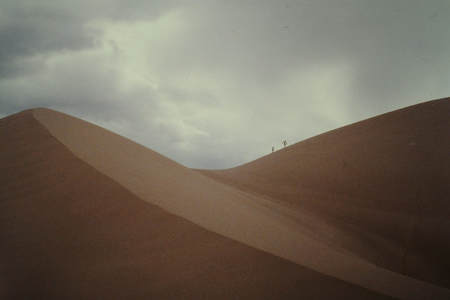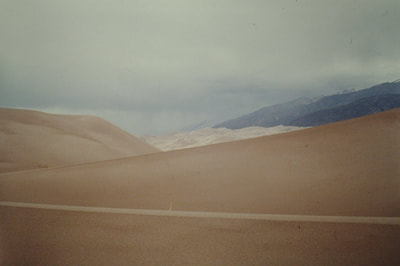At the base of a high mountain range stands a massive dune field, with peaks hundreds of feet high, and sharp sand ridges running all directions in a web-like network. Sand blowing across the valley floor has collected here for hundreds of thousands of years, and the sweeping action of seasonally shifting winds keeps it from spreading further. Once in among the dunes, a traveler will often find sand ridges blocking sight in every direction. Only the highest points on the dunes give a consistent view of the mountains and less danger of being lost.
Dimensions Many dune slopes smoothly rise 200 or 300 feet (60-90 m), and the tallest dune peaks exceed 700 feet (200 m) in height above the valley floor. The dune field is about four miles (6 km) across.
Key Details
- Most of the ground within the dune field is fairly steep, but with stable sand surface underfoot. These slopes remain a challenge to climb, in part due to the thin air here at 8000+ feet (2500+ m) of altitude.
- The steepest slopes on the sides of dunes are slip faces, where every spot on the sand surface is ready to slide down when disturbed. The slip face surface is continually re-steepened by a rain of sand blowing over the ridge above, and any object sitting in this slope will be slowly buried as the sand builds up.
- Level ground is a rarity, sometimes found at bases of depressions between dune ridges.
- Some of the easiest travel is along the dune crests, although care must be taken not to misstep and slide or tumble down a slip face. Reversing winds commonly leave altered top rims of dunes, with short, 5-20 foot (2-6 m) high slip faces cresting the relatively gentle side of the main dune ridge. These smaller dune forms can shift yards within weeks, reshaping themselves to alter the skyline of the greater, largely stable dunes.
- While truly hot air temperatures are rare here, summer sun can raise the sand temperature enough to burn bare feet. Lightning strikes are common on the dune ridges and peaks in summer thunderstorms.
- In this high desert, nighttime low temperatures average below freezing eight months out of the year. There are brief periods of snow cover on the dunes each winter.
- In many places high up in the dunes, moist sand can be found less than a foot below the dry sand surface.
- When the wind is low, this is a near soundless place. The hiss of a small sand avalanche can be discerned from some distance, so long as no sand ridge stands between.
- Streams running down from the mountains follow around the perimeter of the dune field, then head further out onto the valley floor. When traveling toward the dunes, one will likely have to wade across one of these streams, a hundred or more feet (10s of meters) wide and inches (10-20 cm) deep, heavily loaded with sand from the dune margins. Underwater mini-dunes of sand visibly move against the current, creating breaking waves on the water surface that can be up to a foot (30 cm) high.
Story Elements

- Reasons characters might enter the dunes: to escape a pursuer, to look for treasure, to get a long-distance view of the valley.
- This would be a terrible place for characters to unexpectedly wake up or be dropped off.
- Sensory experience of the dunes:
- Hot sand – shoes are necessary, and characters will be uncomfortable resting (unless they understand that cooler sand is just inches below the surface).
- Silence - a song or shout can fill a large natural amphitheater here, on mild days.
- Glare – bright sun reflects off dune slopes from all directions.
- Blowing sand stings exposed skin.
- Under cloud shadows, explorers are cold, in direct sun, they bake.
- By taking a few steps up or down, someone on any ridge line could appear or disappear from distant view.
- Traveling at night, cold will be an enemy. A covering of warm, insulating sand might seem like a solution, but could lead to being buried alive.
- Characters that are having an easy time navigating the dunes by walking on ridge lines may see an oncoming lightning storm, so will have to descend onto the lower, more difficult dune slopes.
- Any footstep taken up a slip face may result in a slide just as far back down, on a sheet of collapsing loose sand. This can actually add to the speed of people fleeing a ridge top by their bounding down the slope, so long as they have the agility to keep their feet.
- When winds are active, sand accumulating on a slip face at a dune crest can bury objects within hours or days. These may be exposed weeks or months later when winds blow from a different direction.
- Over decades and centuries, the larger ridge lines can shift and reorganize their branching-star-like patterns. The whole dune field might be imagined as a huge living thing, actively moving ever so slowly in an extended time frame.
- The rain of sand coming down on a slip face can impair vision, a benefit to those above and an added discomfort for those climbing.
- Blowing sand can work its way into instruments with fine moving parts, threatening their immediate function and possibly causing permanent damage.
- Traveling through the streams, characters may find difficult footing on the underwater mini-dunes, as well as cold potable water.
Reference Location
Great Sand Dunes National Park, south-central Colorado.
© Rice-Snows 2017
Proudly powered by Weebly



